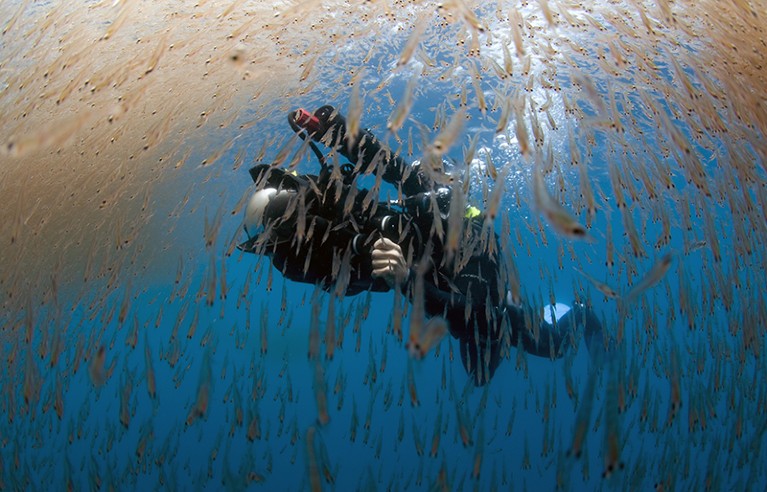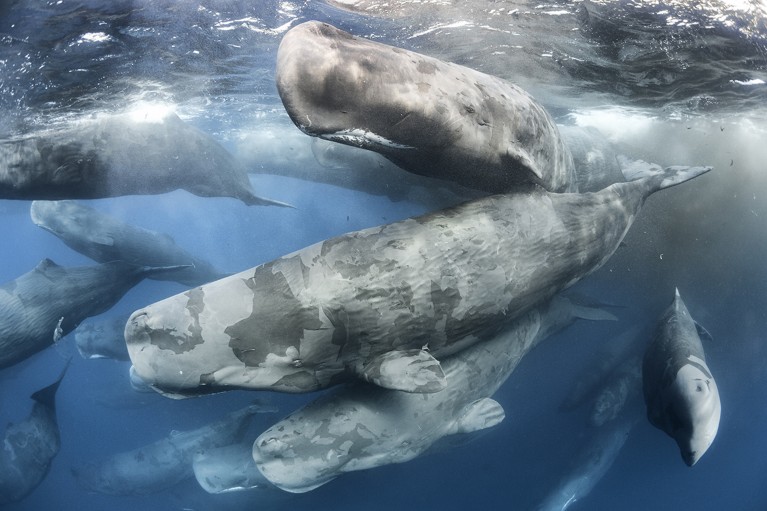Spying on Whales: The Past, Present, and Future of Earth’s Most Awesome Creatures Nick Pyenson Viking (2018)
The Curious Life of Krill: A Conservation Story from the Bottom of the World Stephen Nicol Island (2018)
Orca: How We Came to Know and Love the Ocean’s Greatest Predator Jason M. Colby Oxford University Press (2018)
They cover more than two-thirds of Earth’s surface, support much of its biodiversity, produce more than 50% of planetary oxygen and absorb 20–35% of human-created carbon dioxide emissions. Oceans were once considered boundless resources, yet, by 1983, pioneering whale conservationists Stephen Leatherwood and Randall Reeves were writing in The Sierra Club Handbook of Whales and Dolphins that “the seas are by no means dead, but they are unquestionably less alive than they were when humanity discovered them”.
Ecological connections between species form a tangled web. Intentional perturbations can lead to unintended consequences, or even shift an ecosystem from one state into another. With the human population soaring towards 8 billion — consuming, polluting and emitting as it grows — oceans face unprecedented challenges, as do their denizens. Nearly 3 million whales were killed in the twentieth century; the animals must now negotiate hazards such as ship strikes and noise. And global harvests of ocean fish by humans have hit 1 trillion a year.
Now, three books — by palaeobiologist Nick Pyenson, eminent krill scientist Stephen Nicol and historian Jason Colby — explore oceans from the perspectives of whales and krill across palaeontological, decadal and even annual timescales. They examine the evolutionary history and ecology that led to today’s ecosystems, and provide insights into ocean-resource management and how changing public sentiment influences the politics behind this.
Pyenson’s Spying on Whales is a palaeontological howdunnit embedded in a travelogue devoted to chasing living and extinct whales. The author — curator of fossil marine mammals at the Smithsonian Institution in Washington DC — takes us to field sites from Antarctica to Alaska. His narrative captures the excitement of suction-cup tagging of humpback whales, and of digs in Panama, seeking answers to deep questions in cetacean science. Why are today’s blue whales the largest animals ever to exist? How can past worlds with higher sea levels and more-acidic oceans inform us about the future of today’s oceans as climate change takes hold?
Pyenson likens palaeontology to astronomy for its capacity to transport us in imagination to places never experienced. At Cerro Ballena in northern Chile, he uncovers the densest fossil-whale site yet found, with bones dating to between 6 million and 9 million years ago. Once a tidal flat, the site preserved dozens of whale skeletons. Over at least four separate episodes, these whales and marine mammals unique to South America (walrus-faced whales and aquatic sloths), were probably killed en masse by harmful algal blooms.
The ethics of marine-mammal science can be fraught: research merit, benefits to the population and animal suffering must be weighed up. Many in cetacean science consider it unethical to use specimens from commercial whaling operations, arguing that it supports their continuation. Pyenson is one of few researchers today who collect data, as he puts it, at this “uncomfortable intersection”. Yet his passion for research shines through as he describes the discovery of a previously unknown sensory organ between the unfused lower jawbones of rorqual whales, which might help to coordinate the enormous biomechanics of their gulp when feeding. Clearly also a conservationist at heart, he recognizes that whaling has had much broader ecological consequences than originally imagined.

Thysanoessa krill swarm off California. Krill underpin many marine ecosystems.Credit: Richard Hermann/Minden Pictures/Getty
Nicol’s The Curious Life of Krill takes the reader deep into the Southern Ocean to look at the most abundant multicellular marine organism by weight. Antarctic krill, crustaceans that grow up to 6 centimetres long and feed whales, seals and seabirds, have a 400-million-tonne global biomass. Nicol writes passionately about their biology, exploitation and management. He notes how fisheries have been hampered by krill biology, because the creatures’ digestive enzymes cause rapid degradation after death. (Remarkably, these enzymes also have antibiotic properties that could ultimately move krill oil from health food to mainstream medicine.)
Nicol also delves into the influence of whales and whaling on ocean productivity, noting that the twentieth-century decimation of the mammals has not resulted in the krill surplus envisioned. It now seems likely that all whales have a vital role as ecosystem engineers. They transfer nutrients from the depths, where they feed, to surface waters, where their defecation spreads fertilizing iron. That sustains phytoplankton and, in turn, krill. This finding changes how we view marine ecosystems: no longer as a simple producer–consumer economy, but as complex, interlocking ecological webs. These involve consumption, but also recycling of nutrients and minerals, so that 3D movements of organisms, sediment and suspension are also crucial.
Colby’s Orca describes a different kind of catch: the killer whale (Orcinus orca) live-capture industry in the Pacific Northwest of North America. From 1961 to 1976, 270 of the animals were corralled behind nets and 50 of them were taken for display in aquariums. Colby vividly chronicles a rapid change in public sentiment, from acceptance of shooting killer whales as feared pests in the 1960s to protest and sabotage of capture attempts in the 1970s. Colby, whose father helped with some of the captures, weaves into the narrative first-hand interviews with the saga’s main players. The result is immersive and dramatic. Live captures were halted in North America in 1976, and attention then turned to the release of captive whales. However, vast costs and lack of success in freeing the killer whale Keiko (brought to fame in the 1993 film Free Willy) suggest that conservation efforts would be better focused on the habitats and prey of remaining wild populations.
Our human tendency to shoot first and ask questions later is evident in whaling, krill fishing and the live capture of killer whales. Consumption is only later followed by research programmes to establish management regulations. Among those landmark pieces of legislation are the US Marine Mammal Protection Act of 1972 and the 1980 international Convention on the Conservation of Antarctic Marine Living Resources, described by Colby and Nicol, respectively. Both measures are rightly applauded for their ecological, precautionary and data-driven approaches. However, both are still predicated on quotas for removal, or ‘take’. Nicol briefly mentions the focus in recent years on marine protected areas — initiatives that can prohibit fishing and provide refuges for marine species. These present an alternative management tool that should be quantitatively considered in the evaluation and design of what needs protection, and where.
Spying on Whales, The Curious Life of Krill and Orca acknowledge that our oceans are emptier now than they were only 200 years ago. Our ‘shifting ecological baselines’ lead us to value the best of the worst of our impoverished systems today — to marvel at only moderate productivity. Whereas Pyenson and Nicol help to reset our expectations and wake us from our societal and generational amnesia, Colby demonstrates the speed at which societal attitudes can also shift the baseline of our expectations. In this age of extinction, with ongoing changes in ocean chemistry and physics, it is the potential for a sea change in public attitude that presents hope.


 Marine biodiversity needs more than protection
Marine biodiversity needs more than protection
 Cetacean subtleties
Cetacean subtleties
 Harpoons and heartstrings
Harpoons and heartstrings
 How science inspired Moby-Dick
How science inspired Moby-Dick








